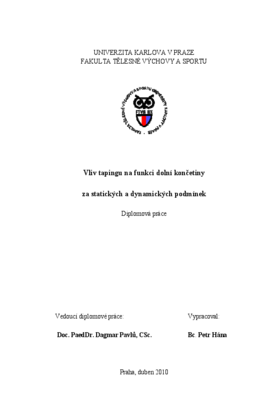Vliv tapingu na funkci dolní končetiny
The Influence of taping on function of lower extermity
diplomová práce (OBHÁJENO)

Zobrazit/
Trvalý odkaz
http://hdl.handle.net/20.500.11956/22008Identifikátory
SIS: 84631
Katalog UK: 990013660880106986
Kolekce
- Kvalifikační práce [9395]
Autor
Vedoucí práce
Oponent práce
Hráský, Pavel
Fakulta / součást
Fakulta tělesné výchovy a sportu
Obor
Fyzioterapie
Katedra / ústav / klinika
Fyzioterapie
Datum obhajoby
10. 5. 2010
Nakladatel
Univerzita Karlova, Fakulta tělesné výchovy a sportuJazyk
Čeština
Známka
Výborně
Souhrn Název: Vliv tapingu na funkci dolní končetiny za statických a dynamických podmínek Cíle: Cílem této práce je zhodnocení efektu tapingu na dolní končetinu za statických a dynamických podmínek. Metody: Pro testování za dynamických podmínek bylo zvoleno měření tlakové síly v mediálním a laterálním regionu paty při došlapu. Pro testování za statických podmínek bylo zvoleno měření maximálních výchylek a celkové dráhy CoP. Hodnoty s aplikovaným tapem byly porovnány s hodnotami bez tapu. Testovaný soubor představovaly čtyři atletky, vybrané podle záměrně zvolených parametrů. K testování bylo použito zařízení Footscan. Výsledky: Neprokázalo se zvýšení celkové dráhy CoP po palikaci tapu. V oblasti paty došlo při došlapu s aplikovaným tapem k snížení rozdílu velikosti tlakové síly mezi mediálním a laterálním regionem. Uváděné výsledky jsou platné pouze pro tuto experimentální skupinu, použitý způsob tapingu a formu testování. Klíčová slova: tape, zatížení, tlaková síla, propriocepce
Title: Training of Asi-waza technics by younger school age children Objectives: The main target of this diploma thesis is to set a complete methodology procedures of training special technics aši-waza by younger schoul age children. Than to provide an information combined with children training problems. Another goal is to invent reservoir of exercises for setting up training units focused on aši-waza technics. Methods: Principles of this thesis are analysis and synthesis methods, that are used with formation of methodic technic activities aši-waza. Individual technics are divided in parts for easier understanding of children. Afterwards parts are combined in one unit again. In the end there are used testing methods for comparison of moving ability changes. Results: After repeating re-test have been stated that aši-waza technic training and training units which are focused on managing these technics have positive effect on developing some movement abilities. Keywords: pre-school age, judo, aši-waza, training unit, movement abilities
